Business and Business Environment Essay
VerifiedAdded on 2020/12/24
|14
|4152
|377
Essay
AI Summary
This essay examines the impact of the business environment on organizations, focusing on the UK retail sector. It analyzes the macro environment using the PESTEL model, examines the strengths, weaknesses, opportunities, and threats of Marks & Spencer through SWOT analysis, and applies Porter's Five Forces model to assess the competitive landscape. The essay concludes by discussing the importance of understanding the business environment for organizational success. Desklib provides past papers and solved assignments for students.
Contribute Materials
Your contribution can guide someone’s learning journey. Share your
documents today.
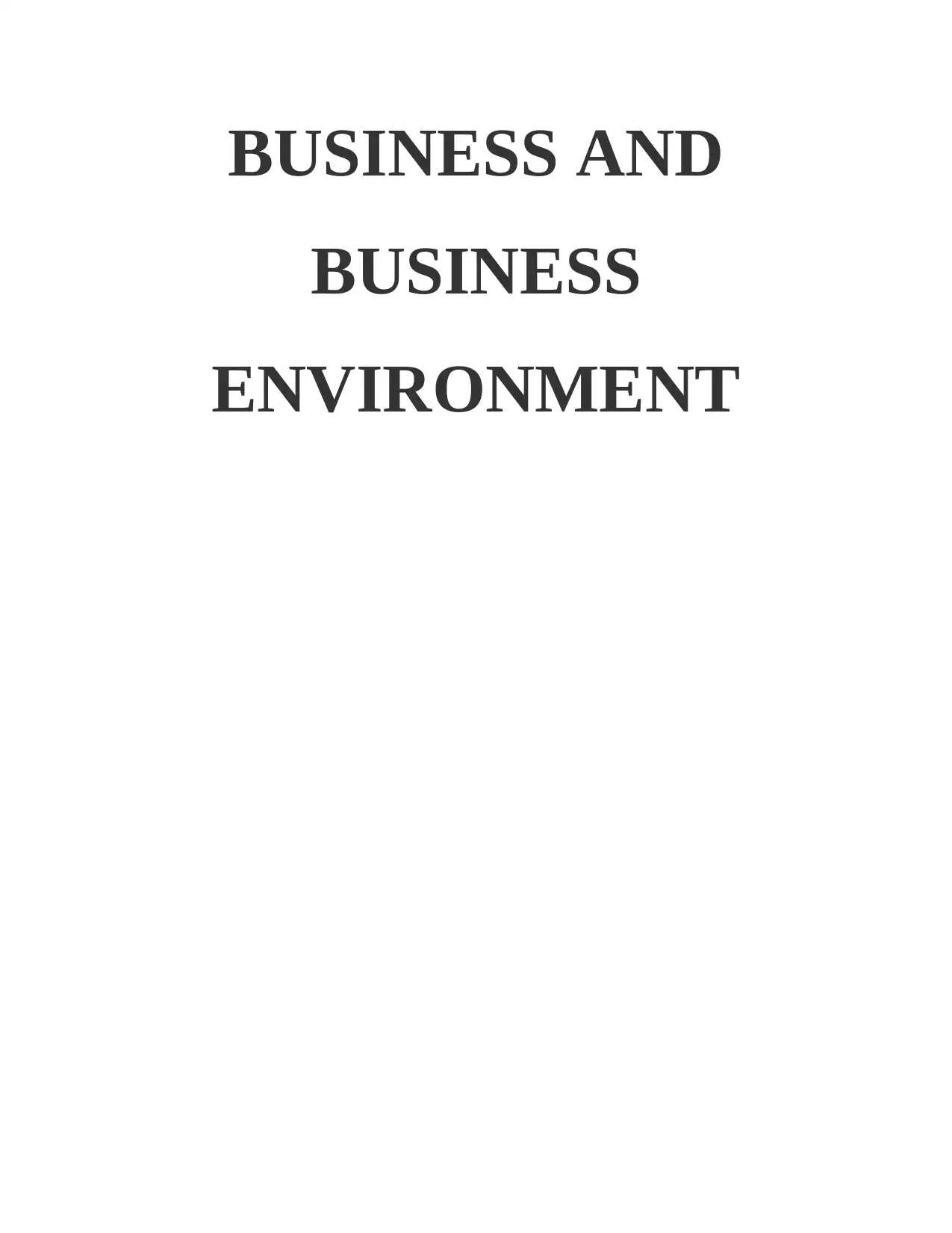
BUSINESS AND
BUSINESS
ENVIRONMENT
BUSINESS
ENVIRONMENT
Secure Best Marks with AI Grader
Need help grading? Try our AI Grader for instant feedback on your assignments.
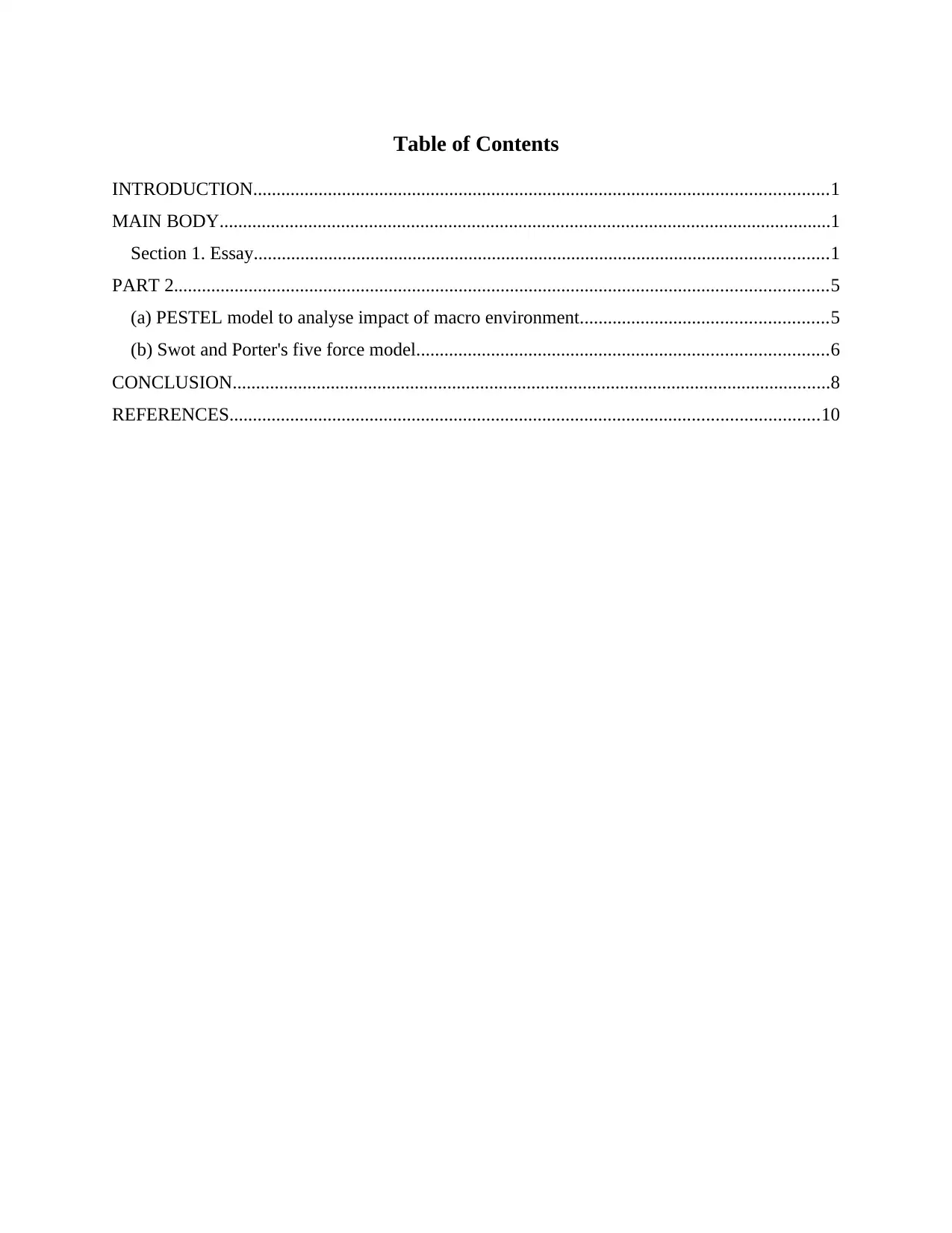
Table of Contents
INTRODUCTION...........................................................................................................................1
MAIN BODY...................................................................................................................................1
Section 1. Essay...........................................................................................................................1
PART 2............................................................................................................................................5
(a) PESTEL model to analyse impact of macro environment.....................................................5
(b) Swot and Porter's five force model........................................................................................6
CONCLUSION................................................................................................................................8
REFERENCES..............................................................................................................................10
INTRODUCTION...........................................................................................................................1
MAIN BODY...................................................................................................................................1
Section 1. Essay...........................................................................................................................1
PART 2............................................................................................................................................5
(a) PESTEL model to analyse impact of macro environment.....................................................5
(b) Swot and Porter's five force model........................................................................................6
CONCLUSION................................................................................................................................8
REFERENCES..............................................................................................................................10

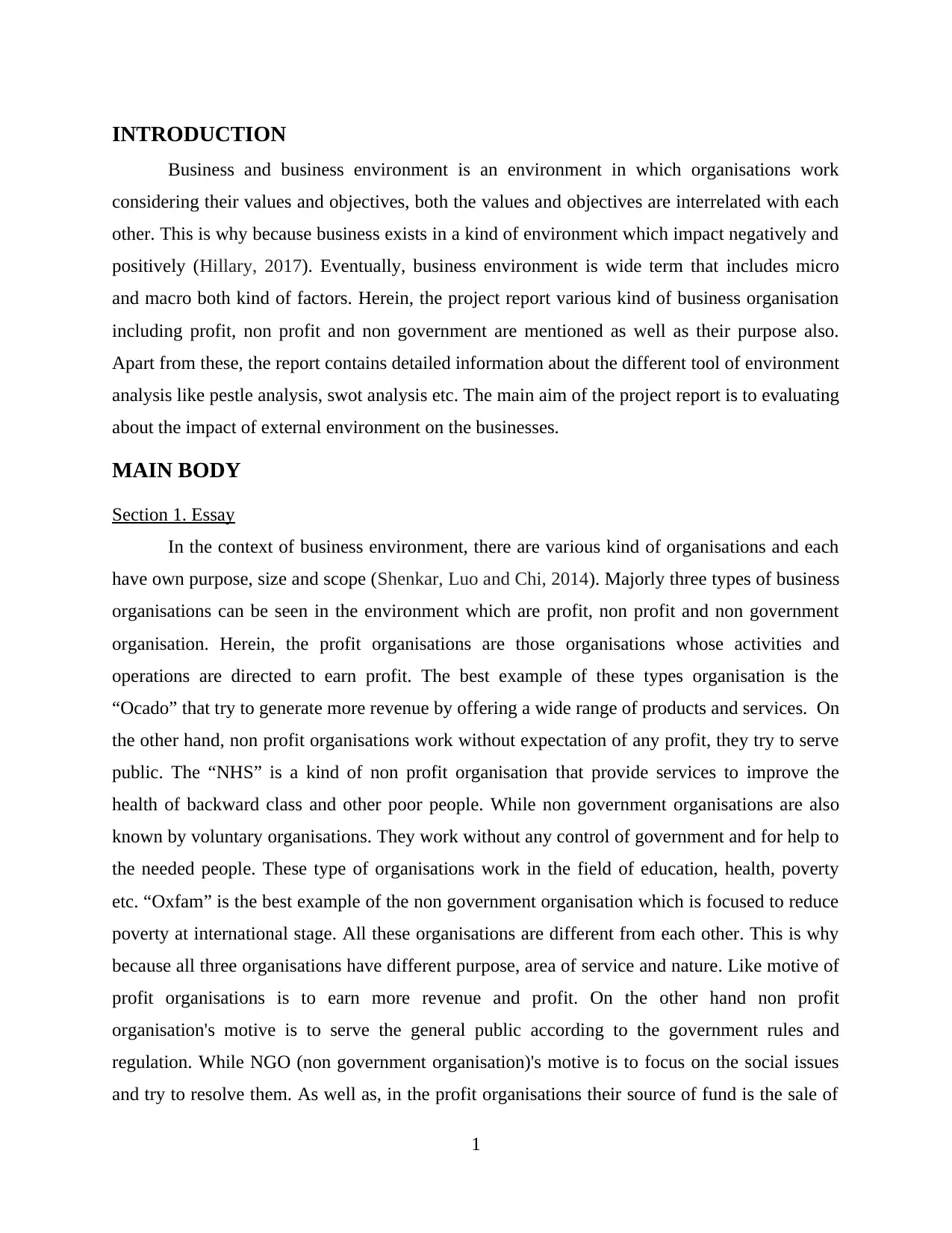
INTRODUCTION
Business and business environment is an environment in which organisations work
considering their values and objectives, both the values and objectives are interrelated with each
other. This is why because business exists in a kind of environment which impact negatively and
positively (Hillary, 2017). Eventually, business environment is wide term that includes micro
and macro both kind of factors. Herein, the project report various kind of business organisation
including profit, non profit and non government are mentioned as well as their purpose also.
Apart from these, the report contains detailed information about the different tool of environment
analysis like pestle analysis, swot analysis etc. The main aim of the project report is to evaluating
about the impact of external environment on the businesses.
MAIN BODY
Section 1. Essay
In the context of business environment, there are various kind of organisations and each
have own purpose, size and scope (Shenkar, Luo and Chi, 2014). Majorly three types of business
organisations can be seen in the environment which are profit, non profit and non government
organisation. Herein, the profit organisations are those organisations whose activities and
operations are directed to earn profit. The best example of these types organisation is the
“Ocado” that try to generate more revenue by offering a wide range of products and services. On
the other hand, non profit organisations work without expectation of any profit, they try to serve
public. The “NHS” is a kind of non profit organisation that provide services to improve the
health of backward class and other poor people. While non government organisations are also
known by voluntary organisations. They work without any control of government and for help to
the needed people. These type of organisations work in the field of education, health, poverty
etc. “Oxfam” is the best example of the non government organisation which is focused to reduce
poverty at international stage. All these organisations are different from each other. This is why
because all three organisations have different purpose, area of service and nature. Like motive of
profit organisations is to earn more revenue and profit. On the other hand non profit
organisation's motive is to serve the general public according to the government rules and
regulation. While NGO (non government organisation)'s motive is to focus on the social issues
and try to resolve them. As well as, in the profit organisations their source of fund is the sale of
1
Business and business environment is an environment in which organisations work
considering their values and objectives, both the values and objectives are interrelated with each
other. This is why because business exists in a kind of environment which impact negatively and
positively (Hillary, 2017). Eventually, business environment is wide term that includes micro
and macro both kind of factors. Herein, the project report various kind of business organisation
including profit, non profit and non government are mentioned as well as their purpose also.
Apart from these, the report contains detailed information about the different tool of environment
analysis like pestle analysis, swot analysis etc. The main aim of the project report is to evaluating
about the impact of external environment on the businesses.
MAIN BODY
Section 1. Essay
In the context of business environment, there are various kind of organisations and each
have own purpose, size and scope (Shenkar, Luo and Chi, 2014). Majorly three types of business
organisations can be seen in the environment which are profit, non profit and non government
organisation. Herein, the profit organisations are those organisations whose activities and
operations are directed to earn profit. The best example of these types organisation is the
“Ocado” that try to generate more revenue by offering a wide range of products and services. On
the other hand, non profit organisations work without expectation of any profit, they try to serve
public. The “NHS” is a kind of non profit organisation that provide services to improve the
health of backward class and other poor people. While non government organisations are also
known by voluntary organisations. They work without any control of government and for help to
the needed people. These type of organisations work in the field of education, health, poverty
etc. “Oxfam” is the best example of the non government organisation which is focused to reduce
poverty at international stage. All these organisations are different from each other. This is why
because all three organisations have different purpose, area of service and nature. Like motive of
profit organisations is to earn more revenue and profit. On the other hand non profit
organisation's motive is to serve the general public according to the government rules and
regulation. While NGO (non government organisation)'s motive is to focus on the social issues
and try to resolve them. As well as, in the profit organisations their source of fund is the sale of
1
Secure Best Marks with AI Grader
Need help grading? Try our AI Grader for instant feedback on your assignments.
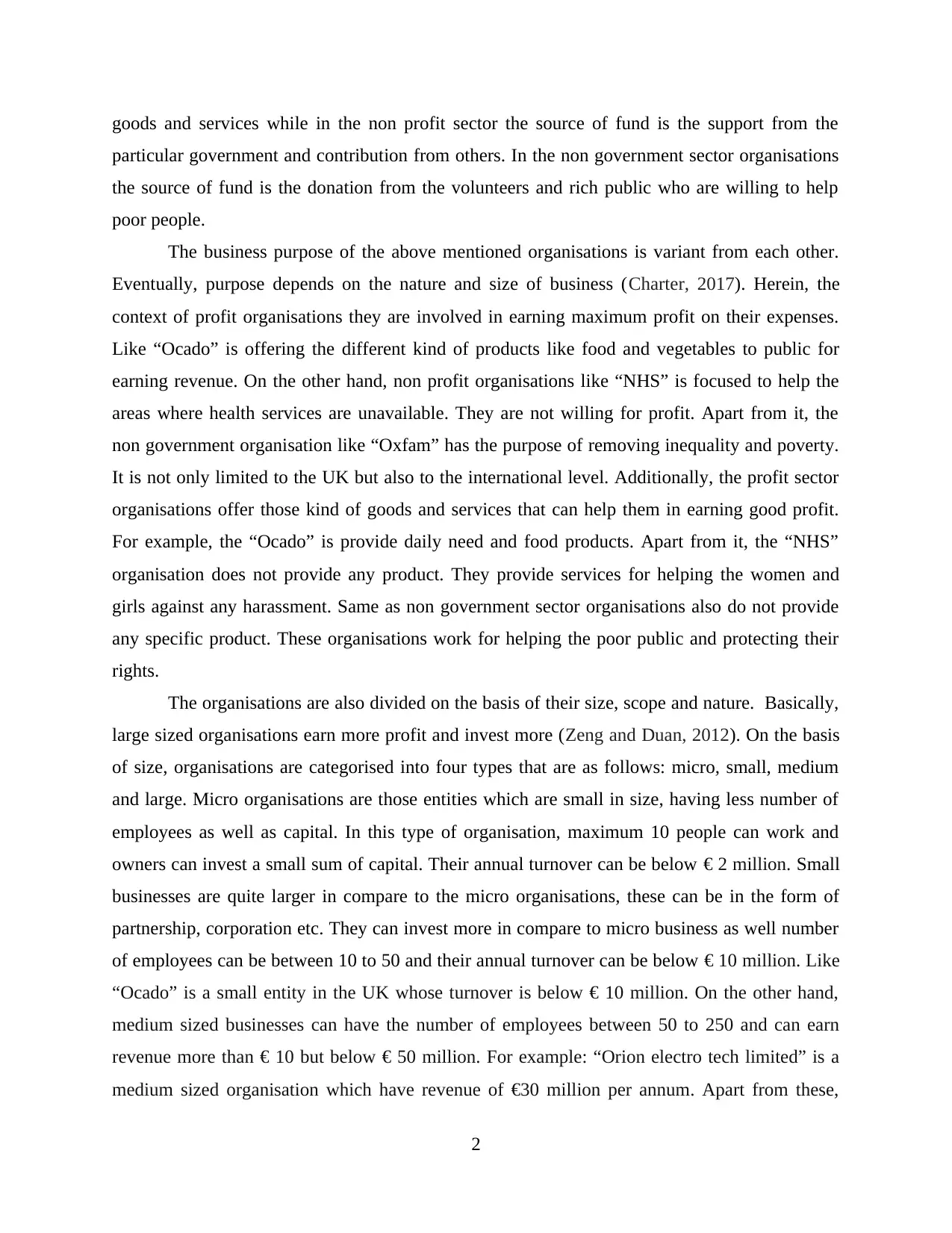
goods and services while in the non profit sector the source of fund is the support from the
particular government and contribution from others. In the non government sector organisations
the source of fund is the donation from the volunteers and rich public who are willing to help
poor people.
The business purpose of the above mentioned organisations is variant from each other.
Eventually, purpose depends on the nature and size of business (Charter, 2017). Herein, the
context of profit organisations they are involved in earning maximum profit on their expenses.
Like “Ocado” is offering the different kind of products like food and vegetables to public for
earning revenue. On the other hand, non profit organisations like “NHS” is focused to help the
areas where health services are unavailable. They are not willing for profit. Apart from it, the
non government organisation like “Oxfam” has the purpose of removing inequality and poverty.
It is not only limited to the UK but also to the international level. Additionally, the profit sector
organisations offer those kind of goods and services that can help them in earning good profit.
For example, the “Ocado” is provide daily need and food products. Apart from it, the “NHS”
organisation does not provide any product. They provide services for helping the women and
girls against any harassment. Same as non government sector organisations also do not provide
any specific product. These organisations work for helping the poor public and protecting their
rights.
The organisations are also divided on the basis of their size, scope and nature. Basically,
large sized organisations earn more profit and invest more (Zeng and Duan, 2012). On the basis
of size, organisations are categorised into four types that are as follows: micro, small, medium
and large. Micro organisations are those entities which are small in size, having less number of
employees as well as capital. In this type of organisation, maximum 10 people can work and
owners can invest a small sum of capital. Their annual turnover can be below € 2 million. Small
businesses are quite larger in compare to the micro organisations, these can be in the form of
partnership, corporation etc. They can invest more in compare to micro business as well number
of employees can be between 10 to 50 and their annual turnover can be below € 10 million. Like
“Ocado” is a small entity in the UK whose turnover is below € 10 million. On the other hand,
medium sized businesses can have the number of employees between 50 to 250 and can earn
revenue more than € 10 but below € 50 million. For example: “Orion electro tech limited” is a
medium sized organisation which have revenue of €30 million per annum. Apart from these,
2
particular government and contribution from others. In the non government sector organisations
the source of fund is the donation from the volunteers and rich public who are willing to help
poor people.
The business purpose of the above mentioned organisations is variant from each other.
Eventually, purpose depends on the nature and size of business (Charter, 2017). Herein, the
context of profit organisations they are involved in earning maximum profit on their expenses.
Like “Ocado” is offering the different kind of products like food and vegetables to public for
earning revenue. On the other hand, non profit organisations like “NHS” is focused to help the
areas where health services are unavailable. They are not willing for profit. Apart from it, the
non government organisation like “Oxfam” has the purpose of removing inequality and poverty.
It is not only limited to the UK but also to the international level. Additionally, the profit sector
organisations offer those kind of goods and services that can help them in earning good profit.
For example, the “Ocado” is provide daily need and food products. Apart from it, the “NHS”
organisation does not provide any product. They provide services for helping the women and
girls against any harassment. Same as non government sector organisations also do not provide
any specific product. These organisations work for helping the poor public and protecting their
rights.
The organisations are also divided on the basis of their size, scope and nature. Basically,
large sized organisations earn more profit and invest more (Zeng and Duan, 2012). On the basis
of size, organisations are categorised into four types that are as follows: micro, small, medium
and large. Micro organisations are those entities which are small in size, having less number of
employees as well as capital. In this type of organisation, maximum 10 people can work and
owners can invest a small sum of capital. Their annual turnover can be below € 2 million. Small
businesses are quite larger in compare to the micro organisations, these can be in the form of
partnership, corporation etc. They can invest more in compare to micro business as well number
of employees can be between 10 to 50 and their annual turnover can be below € 10 million. Like
“Ocado” is a small entity in the UK whose turnover is below € 10 million. On the other hand,
medium sized businesses can have the number of employees between 50 to 250 and can earn
revenue more than € 10 but below € 50 million. For example: “Orion electro tech limited” is a
medium sized organisation which have revenue of €30 million per annum. Apart from these,
2
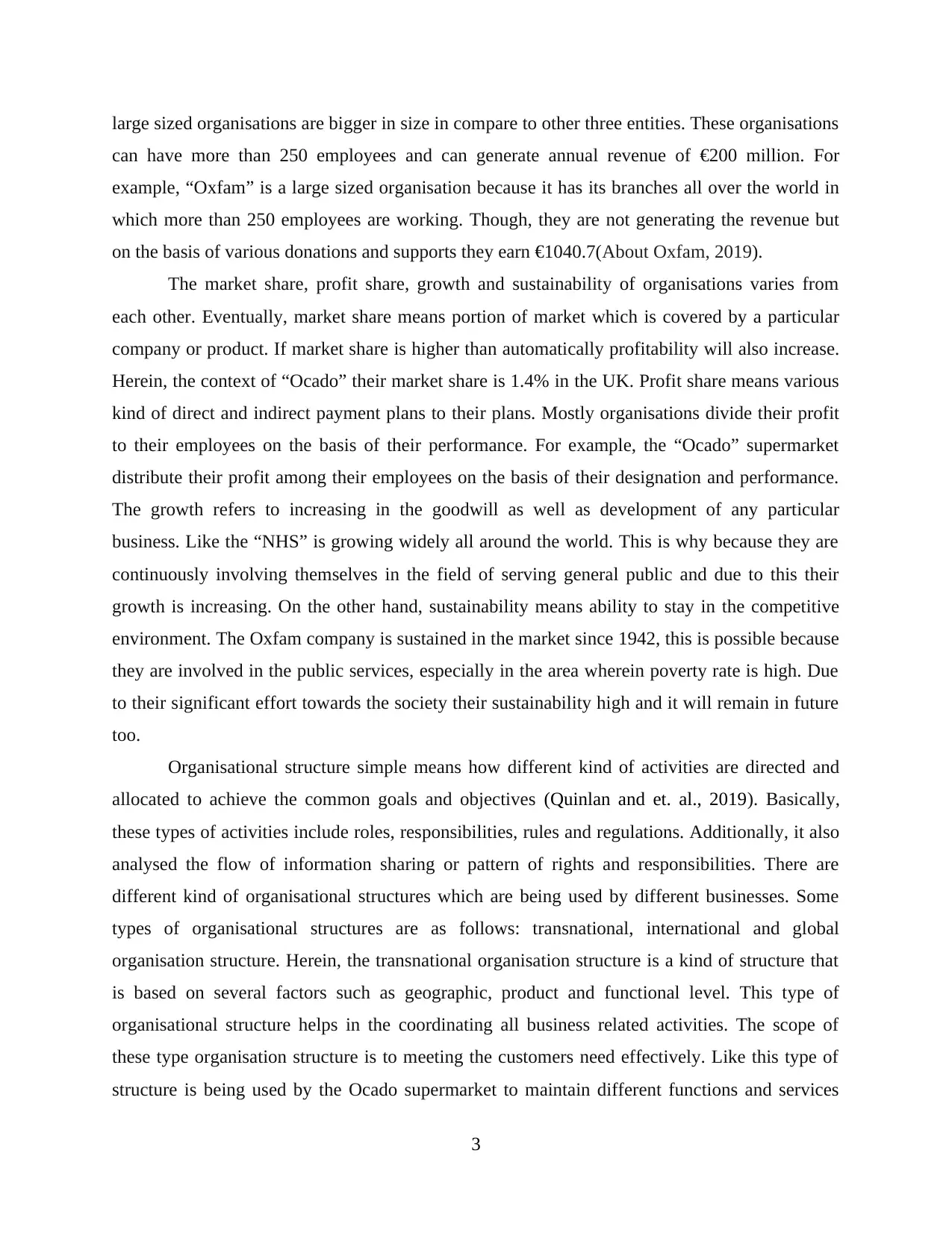
large sized organisations are bigger in size in compare to other three entities. These organisations
can have more than 250 employees and can generate annual revenue of €200 million. For
example, “Oxfam” is a large sized organisation because it has its branches all over the world in
which more than 250 employees are working. Though, they are not generating the revenue but
on the basis of various donations and supports they earn €1040.7(About Oxfam, 2019).
The market share, profit share, growth and sustainability of organisations varies from
each other. Eventually, market share means portion of market which is covered by a particular
company or product. If market share is higher than automatically profitability will also increase.
Herein, the context of “Ocado” their market share is 1.4% in the UK. Profit share means various
kind of direct and indirect payment plans to their plans. Mostly organisations divide their profit
to their employees on the basis of their performance. For example, the “Ocado” supermarket
distribute their profit among their employees on the basis of their designation and performance.
The growth refers to increasing in the goodwill as well as development of any particular
business. Like the “NHS” is growing widely all around the world. This is why because they are
continuously involving themselves in the field of serving general public and due to this their
growth is increasing. On the other hand, sustainability means ability to stay in the competitive
environment. The Oxfam company is sustained in the market since 1942, this is possible because
they are involved in the public services, especially in the area wherein poverty rate is high. Due
to their significant effort towards the society their sustainability high and it will remain in future
too.
Organisational structure simple means how different kind of activities are directed and
allocated to achieve the common goals and objectives (Quinlan and et. al., 2019). Basically,
these types of activities include roles, responsibilities, rules and regulations. Additionally, it also
analysed the flow of information sharing or pattern of rights and responsibilities. There are
different kind of organisational structures which are being used by different businesses. Some
types of organisational structures are as follows: transnational, international and global
organisation structure. Herein, the transnational organisation structure is a kind of structure that
is based on several factors such as geographic, product and functional level. This type of
organisational structure helps in the coordinating all business related activities. The scope of
these type organisation structure is to meeting the customers need effectively. Like this type of
structure is being used by the Ocado supermarket to maintain different functions and services
3
can have more than 250 employees and can generate annual revenue of €200 million. For
example, “Oxfam” is a large sized organisation because it has its branches all over the world in
which more than 250 employees are working. Though, they are not generating the revenue but
on the basis of various donations and supports they earn €1040.7(About Oxfam, 2019).
The market share, profit share, growth and sustainability of organisations varies from
each other. Eventually, market share means portion of market which is covered by a particular
company or product. If market share is higher than automatically profitability will also increase.
Herein, the context of “Ocado” their market share is 1.4% in the UK. Profit share means various
kind of direct and indirect payment plans to their plans. Mostly organisations divide their profit
to their employees on the basis of their performance. For example, the “Ocado” supermarket
distribute their profit among their employees on the basis of their designation and performance.
The growth refers to increasing in the goodwill as well as development of any particular
business. Like the “NHS” is growing widely all around the world. This is why because they are
continuously involving themselves in the field of serving general public and due to this their
growth is increasing. On the other hand, sustainability means ability to stay in the competitive
environment. The Oxfam company is sustained in the market since 1942, this is possible because
they are involved in the public services, especially in the area wherein poverty rate is high. Due
to their significant effort towards the society their sustainability high and it will remain in future
too.
Organisational structure simple means how different kind of activities are directed and
allocated to achieve the common goals and objectives (Quinlan and et. al., 2019). Basically,
these types of activities include roles, responsibilities, rules and regulations. Additionally, it also
analysed the flow of information sharing or pattern of rights and responsibilities. There are
different kind of organisational structures which are being used by different businesses. Some
types of organisational structures are as follows: transnational, international and global
organisation structure. Herein, the transnational organisation structure is a kind of structure that
is based on several factors such as geographic, product and functional level. This type of
organisational structure helps in the coordinating all business related activities. The scope of
these type organisation structure is to meeting the customers need effectively. Like this type of
structure is being used by the Ocado supermarket to maintain different functions and services
3
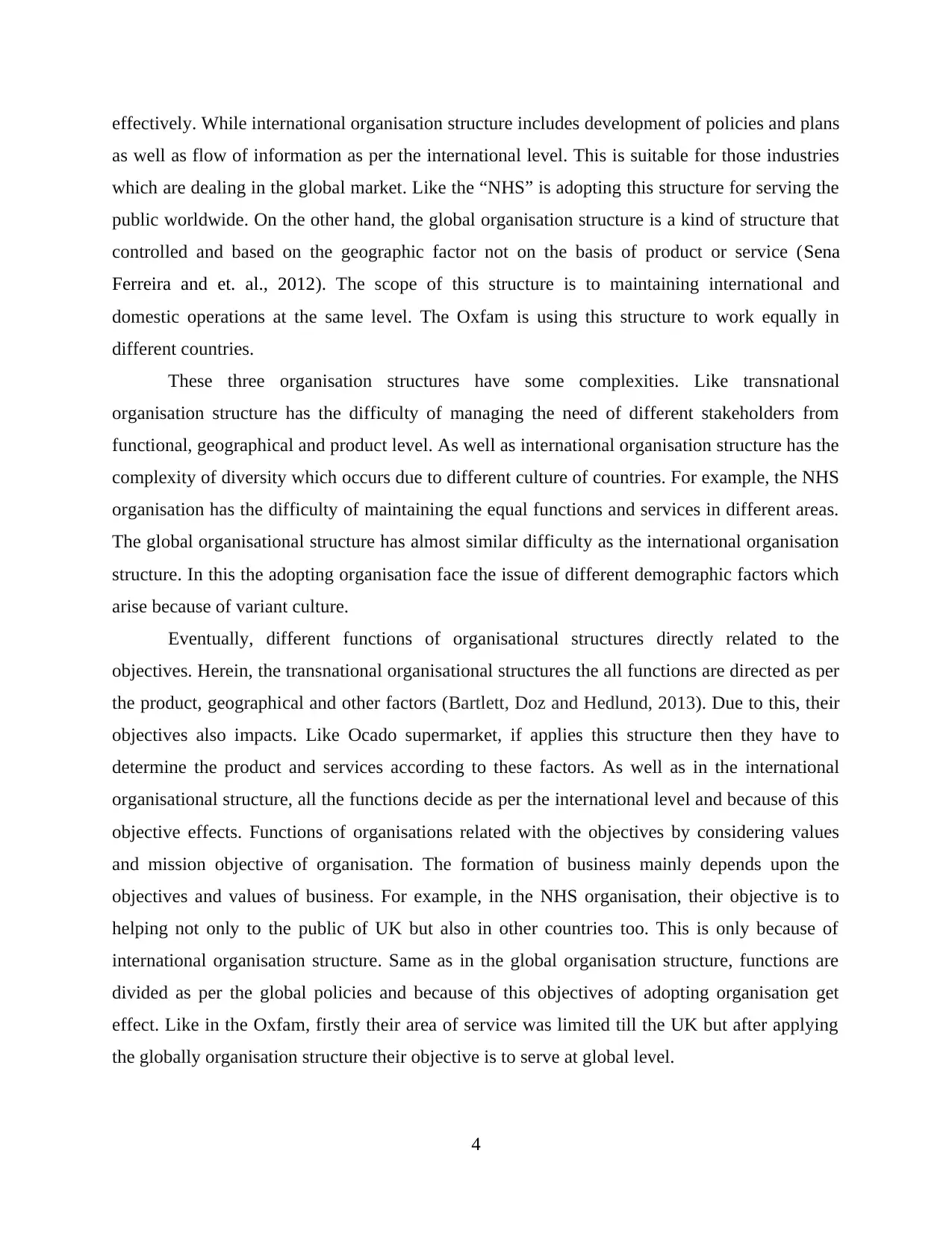
effectively. While international organisation structure includes development of policies and plans
as well as flow of information as per the international level. This is suitable for those industries
which are dealing in the global market. Like the “NHS” is adopting this structure for serving the
public worldwide. On the other hand, the global organisation structure is a kind of structure that
controlled and based on the geographic factor not on the basis of product or service (Sena
Ferreira and et. al., 2012). The scope of this structure is to maintaining international and
domestic operations at the same level. The Oxfam is using this structure to work equally in
different countries.
These three organisation structures have some complexities. Like transnational
organisation structure has the difficulty of managing the need of different stakeholders from
functional, geographical and product level. As well as international organisation structure has the
complexity of diversity which occurs due to different culture of countries. For example, the NHS
organisation has the difficulty of maintaining the equal functions and services in different areas.
The global organisational structure has almost similar difficulty as the international organisation
structure. In this the adopting organisation face the issue of different demographic factors which
arise because of variant culture.
Eventually, different functions of organisational structures directly related to the
objectives. Herein, the transnational organisational structures the all functions are directed as per
the product, geographical and other factors (Bartlett, Doz and Hedlund, 2013). Due to this, their
objectives also impacts. Like Ocado supermarket, if applies this structure then they have to
determine the product and services according to these factors. As well as in the international
organisational structure, all the functions decide as per the international level and because of this
objective effects. Functions of organisations related with the objectives by considering values
and mission objective of organisation. The formation of business mainly depends upon the
objectives and values of business. For example, in the NHS organisation, their objective is to
helping not only to the public of UK but also in other countries too. This is only because of
international organisation structure. Same as in the global organisation structure, functions are
divided as per the global policies and because of this objectives of adopting organisation get
effect. Like in the Oxfam, firstly their area of service was limited till the UK but after applying
the globally organisation structure their objective is to serve at global level.
4
as well as flow of information as per the international level. This is suitable for those industries
which are dealing in the global market. Like the “NHS” is adopting this structure for serving the
public worldwide. On the other hand, the global organisation structure is a kind of structure that
controlled and based on the geographic factor not on the basis of product or service (Sena
Ferreira and et. al., 2012). The scope of this structure is to maintaining international and
domestic operations at the same level. The Oxfam is using this structure to work equally in
different countries.
These three organisation structures have some complexities. Like transnational
organisation structure has the difficulty of managing the need of different stakeholders from
functional, geographical and product level. As well as international organisation structure has the
complexity of diversity which occurs due to different culture of countries. For example, the NHS
organisation has the difficulty of maintaining the equal functions and services in different areas.
The global organisational structure has almost similar difficulty as the international organisation
structure. In this the adopting organisation face the issue of different demographic factors which
arise because of variant culture.
Eventually, different functions of organisational structures directly related to the
objectives. Herein, the transnational organisational structures the all functions are directed as per
the product, geographical and other factors (Bartlett, Doz and Hedlund, 2013). Due to this, their
objectives also impacts. Like Ocado supermarket, if applies this structure then they have to
determine the product and services according to these factors. As well as in the international
organisational structure, all the functions decide as per the international level and because of this
objective effects. Functions of organisations related with the objectives by considering values
and mission objective of organisation. The formation of business mainly depends upon the
objectives and values of business. For example, in the NHS organisation, their objective is to
helping not only to the public of UK but also in other countries too. This is only because of
international organisation structure. Same as in the global organisation structure, functions are
divided as per the global policies and because of this objectives of adopting organisation get
effect. Like in the Oxfam, firstly their area of service was limited till the UK but after applying
the globally organisation structure their objective is to serve at global level.
4
Paraphrase This Document
Need a fresh take? Get an instant paraphrase of this document with our AI Paraphraser
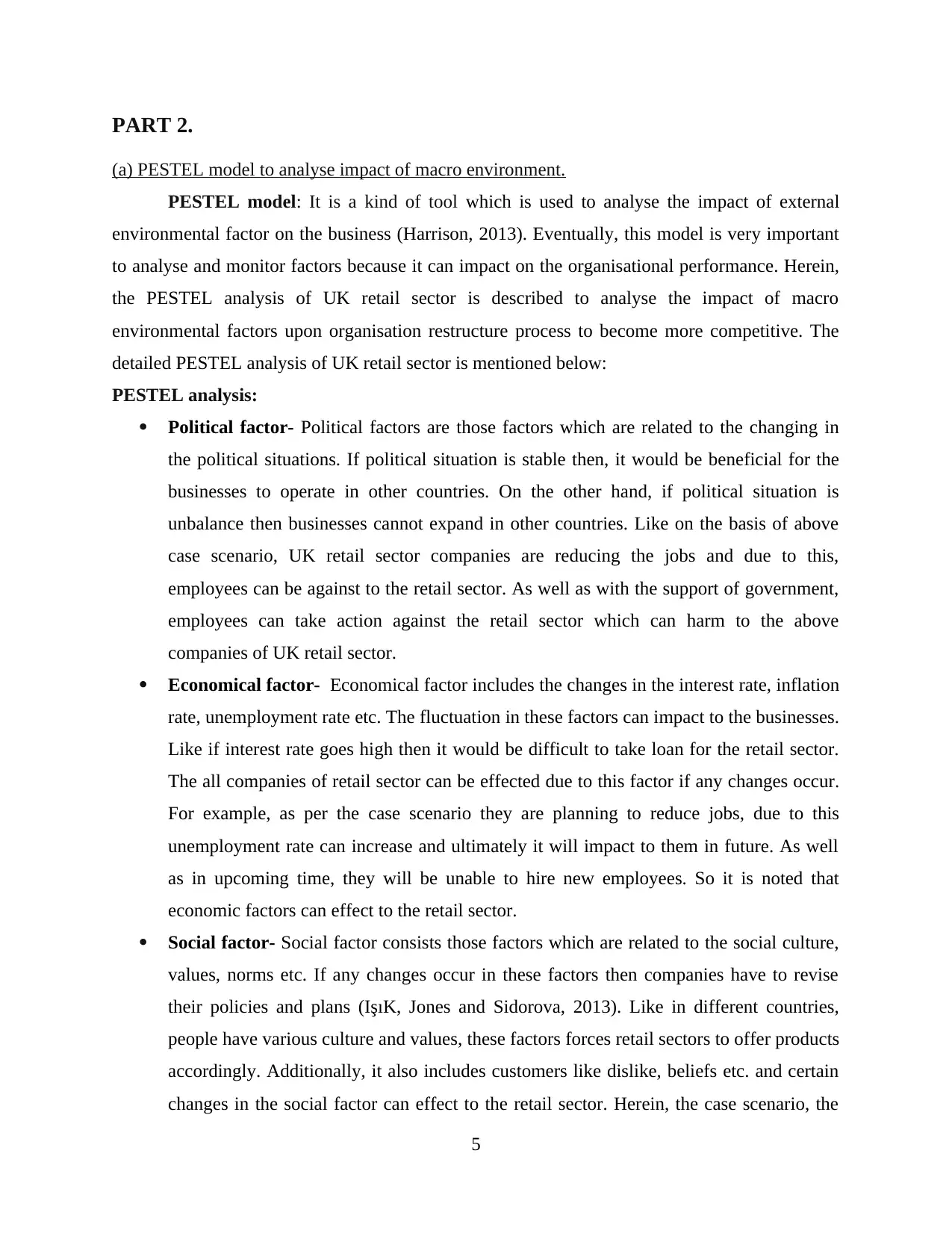
PART 2.
(a) PESTEL model to analyse impact of macro environment.
PESTEL model: It is a kind of tool which is used to analyse the impact of external
environmental factor on the business (Harrison, 2013). Eventually, this model is very important
to analyse and monitor factors because it can impact on the organisational performance. Herein,
the PESTEL analysis of UK retail sector is described to analyse the impact of macro
environmental factors upon organisation restructure process to become more competitive. The
detailed PESTEL analysis of UK retail sector is mentioned below:
PESTEL analysis:
Political factor- Political factors are those factors which are related to the changing in
the political situations. If political situation is stable then, it would be beneficial for the
businesses to operate in other countries. On the other hand, if political situation is
unbalance then businesses cannot expand in other countries. Like on the basis of above
case scenario, UK retail sector companies are reducing the jobs and due to this,
employees can be against to the retail sector. As well as with the support of government,
employees can take action against the retail sector which can harm to the above
companies of UK retail sector.
Economical factor- Economical factor includes the changes in the interest rate, inflation
rate, unemployment rate etc. The fluctuation in these factors can impact to the businesses.
Like if interest rate goes high then it would be difficult to take loan for the retail sector.
The all companies of retail sector can be effected due to this factor if any changes occur.
For example, as per the case scenario they are planning to reduce jobs, due to this
unemployment rate can increase and ultimately it will impact to them in future. As well
as in upcoming time, they will be unable to hire new employees. So it is noted that
economic factors can effect to the retail sector.
Social factor- Social factor consists those factors which are related to the social culture,
values, norms etc. If any changes occur in these factors then companies have to revise
their policies and plans (IşıK, Jones and Sidorova, 2013). Like in different countries,
people have various culture and values, these factors forces retail sectors to offer products
accordingly. Additionally, it also includes customers like dislike, beliefs etc. and certain
changes in the social factor can effect to the retail sector. Herein, the case scenario, the
5
(a) PESTEL model to analyse impact of macro environment.
PESTEL model: It is a kind of tool which is used to analyse the impact of external
environmental factor on the business (Harrison, 2013). Eventually, this model is very important
to analyse and monitor factors because it can impact on the organisational performance. Herein,
the PESTEL analysis of UK retail sector is described to analyse the impact of macro
environmental factors upon organisation restructure process to become more competitive. The
detailed PESTEL analysis of UK retail sector is mentioned below:
PESTEL analysis:
Political factor- Political factors are those factors which are related to the changing in
the political situations. If political situation is stable then, it would be beneficial for the
businesses to operate in other countries. On the other hand, if political situation is
unbalance then businesses cannot expand in other countries. Like on the basis of above
case scenario, UK retail sector companies are reducing the jobs and due to this,
employees can be against to the retail sector. As well as with the support of government,
employees can take action against the retail sector which can harm to the above
companies of UK retail sector.
Economical factor- Economical factor includes the changes in the interest rate, inflation
rate, unemployment rate etc. The fluctuation in these factors can impact to the businesses.
Like if interest rate goes high then it would be difficult to take loan for the retail sector.
The all companies of retail sector can be effected due to this factor if any changes occur.
For example, as per the case scenario they are planning to reduce jobs, due to this
unemployment rate can increase and ultimately it will impact to them in future. As well
as in upcoming time, they will be unable to hire new employees. So it is noted that
economic factors can effect to the retail sector.
Social factor- Social factor consists those factors which are related to the social culture,
values, norms etc. If any changes occur in these factors then companies have to revise
their policies and plans (IşıK, Jones and Sidorova, 2013). Like in different countries,
people have various culture and values, these factors forces retail sectors to offer products
accordingly. Additionally, it also includes customers like dislike, beliefs etc. and certain
changes in the social factor can effect to the retail sector. Herein, the case scenario, the
5
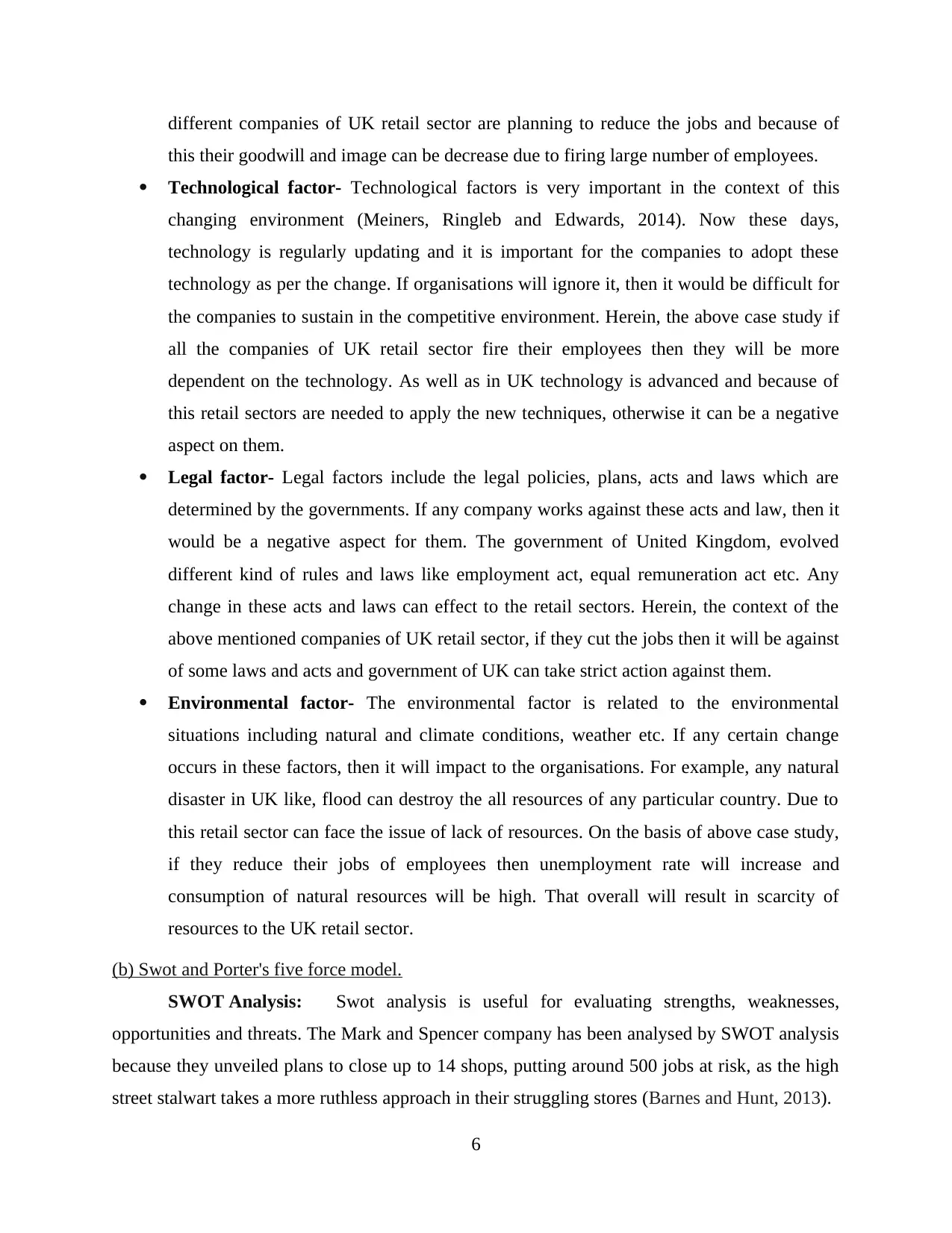
different companies of UK retail sector are planning to reduce the jobs and because of
this their goodwill and image can be decrease due to firing large number of employees.
Technological factor- Technological factors is very important in the context of this
changing environment (Meiners, Ringleb and Edwards, 2014). Now these days,
technology is regularly updating and it is important for the companies to adopt these
technology as per the change. If organisations will ignore it, then it would be difficult for
the companies to sustain in the competitive environment. Herein, the above case study if
all the companies of UK retail sector fire their employees then they will be more
dependent on the technology. As well as in UK technology is advanced and because of
this retail sectors are needed to apply the new techniques, otherwise it can be a negative
aspect on them.
Legal factor- Legal factors include the legal policies, plans, acts and laws which are
determined by the governments. If any company works against these acts and law, then it
would be a negative aspect for them. The government of United Kingdom, evolved
different kind of rules and laws like employment act, equal remuneration act etc. Any
change in these acts and laws can effect to the retail sectors. Herein, the context of the
above mentioned companies of UK retail sector, if they cut the jobs then it will be against
of some laws and acts and government of UK can take strict action against them.
Environmental factor- The environmental factor is related to the environmental
situations including natural and climate conditions, weather etc. If any certain change
occurs in these factors, then it will impact to the organisations. For example, any natural
disaster in UK like, flood can destroy the all resources of any particular country. Due to
this retail sector can face the issue of lack of resources. On the basis of above case study,
if they reduce their jobs of employees then unemployment rate will increase and
consumption of natural resources will be high. That overall will result in scarcity of
resources to the UK retail sector.
(b) Swot and Porter's five force model.
SWOT Analysis: Swot analysis is useful for evaluating strengths, weaknesses,
opportunities and threats. The Mark and Spencer company has been analysed by SWOT analysis
because they unveiled plans to close up to 14 shops, putting around 500 jobs at risk, as the high
street stalwart takes a more ruthless approach in their struggling stores (Barnes and Hunt, 2013).
6
this their goodwill and image can be decrease due to firing large number of employees.
Technological factor- Technological factors is very important in the context of this
changing environment (Meiners, Ringleb and Edwards, 2014). Now these days,
technology is regularly updating and it is important for the companies to adopt these
technology as per the change. If organisations will ignore it, then it would be difficult for
the companies to sustain in the competitive environment. Herein, the above case study if
all the companies of UK retail sector fire their employees then they will be more
dependent on the technology. As well as in UK technology is advanced and because of
this retail sectors are needed to apply the new techniques, otherwise it can be a negative
aspect on them.
Legal factor- Legal factors include the legal policies, plans, acts and laws which are
determined by the governments. If any company works against these acts and law, then it
would be a negative aspect for them. The government of United Kingdom, evolved
different kind of rules and laws like employment act, equal remuneration act etc. Any
change in these acts and laws can effect to the retail sectors. Herein, the context of the
above mentioned companies of UK retail sector, if they cut the jobs then it will be against
of some laws and acts and government of UK can take strict action against them.
Environmental factor- The environmental factor is related to the environmental
situations including natural and climate conditions, weather etc. If any certain change
occurs in these factors, then it will impact to the organisations. For example, any natural
disaster in UK like, flood can destroy the all resources of any particular country. Due to
this retail sector can face the issue of lack of resources. On the basis of above case study,
if they reduce their jobs of employees then unemployment rate will increase and
consumption of natural resources will be high. That overall will result in scarcity of
resources to the UK retail sector.
(b) Swot and Porter's five force model.
SWOT Analysis: Swot analysis is useful for evaluating strengths, weaknesses,
opportunities and threats. The Mark and Spencer company has been analysed by SWOT analysis
because they unveiled plans to close up to 14 shops, putting around 500 jobs at risk, as the high
street stalwart takes a more ruthless approach in their struggling stores (Barnes and Hunt, 2013).
6
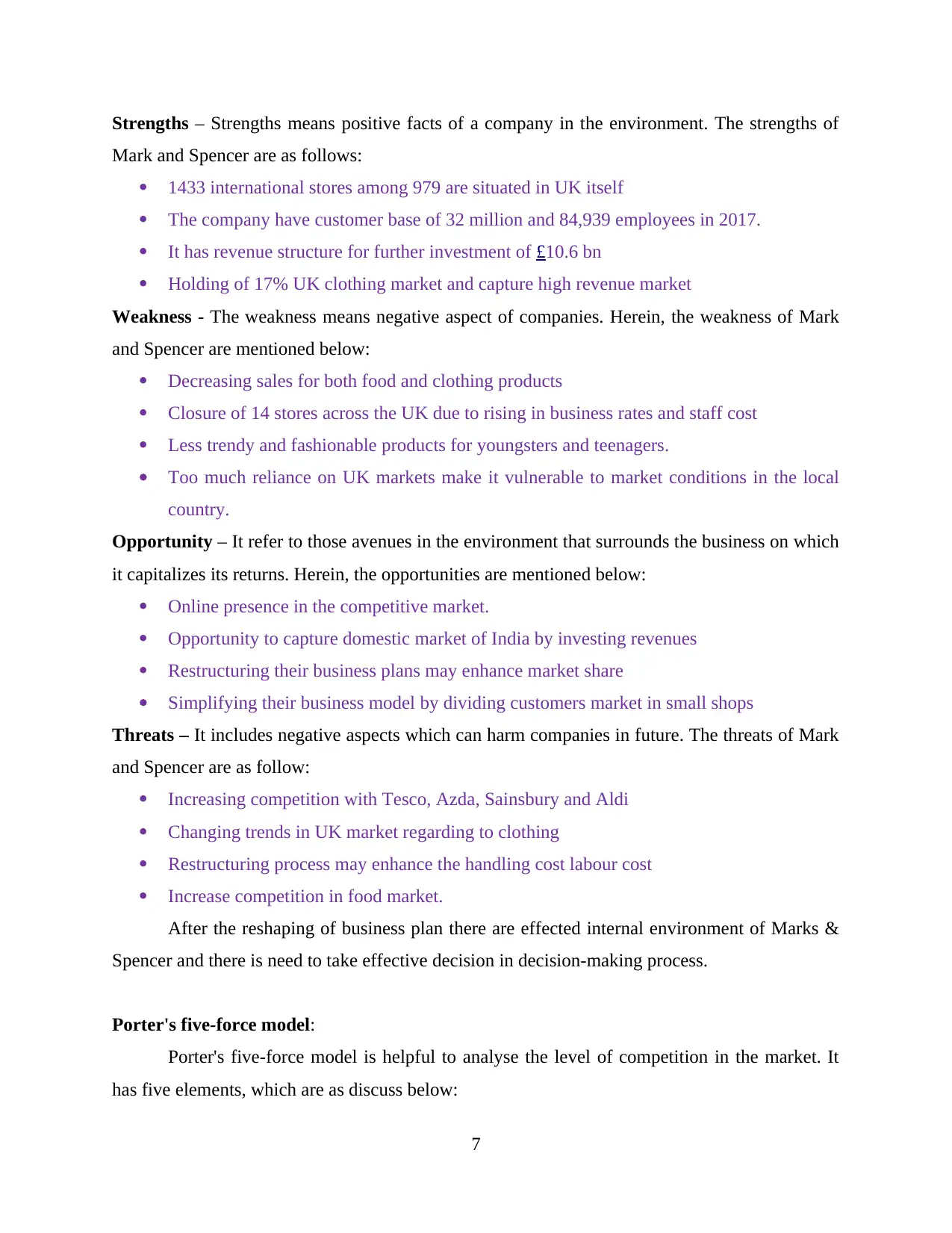
Strengths – Strengths means positive facts of a company in the environment. The strengths of
Mark and Spencer are as follows:
1433 international stores among 979 are situated in UK itself
The company have customer base of 32 million and 84,939 employees in 2017.
It has revenue structure for further investment of £10.6 bn
Holding of 17% UK clothing market and capture high revenue market
Weakness - The weakness means negative aspect of companies. Herein, the weakness of Mark
and Spencer are mentioned below:
Decreasing sales for both food and clothing products
Closure of 14 stores across the UK due to rising in business rates and staff cost
Less trendy and fashionable products for youngsters and teenagers.
Too much reliance on UK markets make it vulnerable to market conditions in the local
country.
Opportunity – It refer to those avenues in the environment that surrounds the business on which
it capitalizes its returns. Herein, the opportunities are mentioned below:
Online presence in the competitive market.
Opportunity to capture domestic market of India by investing revenues
Restructuring their business plans may enhance market share
Simplifying their business model by dividing customers market in small shops
Threats – It includes negative aspects which can harm companies in future. The threats of Mark
and Spencer are as follow:
Increasing competition with Tesco, Azda, Sainsbury and Aldi
Changing trends in UK market regarding to clothing
Restructuring process may enhance the handling cost labour cost
Increase competition in food market.
After the reshaping of business plan there are effected internal environment of Marks &
Spencer and there is need to take effective decision in decision-making process.
Porter's five-force model:
Porter's five-force model is helpful to analyse the level of competition in the market. It
has five elements, which are as discuss below:
7
Mark and Spencer are as follows:
1433 international stores among 979 are situated in UK itself
The company have customer base of 32 million and 84,939 employees in 2017.
It has revenue structure for further investment of £10.6 bn
Holding of 17% UK clothing market and capture high revenue market
Weakness - The weakness means negative aspect of companies. Herein, the weakness of Mark
and Spencer are mentioned below:
Decreasing sales for both food and clothing products
Closure of 14 stores across the UK due to rising in business rates and staff cost
Less trendy and fashionable products for youngsters and teenagers.
Too much reliance on UK markets make it vulnerable to market conditions in the local
country.
Opportunity – It refer to those avenues in the environment that surrounds the business on which
it capitalizes its returns. Herein, the opportunities are mentioned below:
Online presence in the competitive market.
Opportunity to capture domestic market of India by investing revenues
Restructuring their business plans may enhance market share
Simplifying their business model by dividing customers market in small shops
Threats – It includes negative aspects which can harm companies in future. The threats of Mark
and Spencer are as follow:
Increasing competition with Tesco, Azda, Sainsbury and Aldi
Changing trends in UK market regarding to clothing
Restructuring process may enhance the handling cost labour cost
Increase competition in food market.
After the reshaping of business plan there are effected internal environment of Marks &
Spencer and there is need to take effective decision in decision-making process.
Porter's five-force model:
Porter's five-force model is helpful to analyse the level of competition in the market. It
has five elements, which are as discuss below:
7
Secure Best Marks with AI Grader
Need help grading? Try our AI Grader for instant feedback on your assignments.
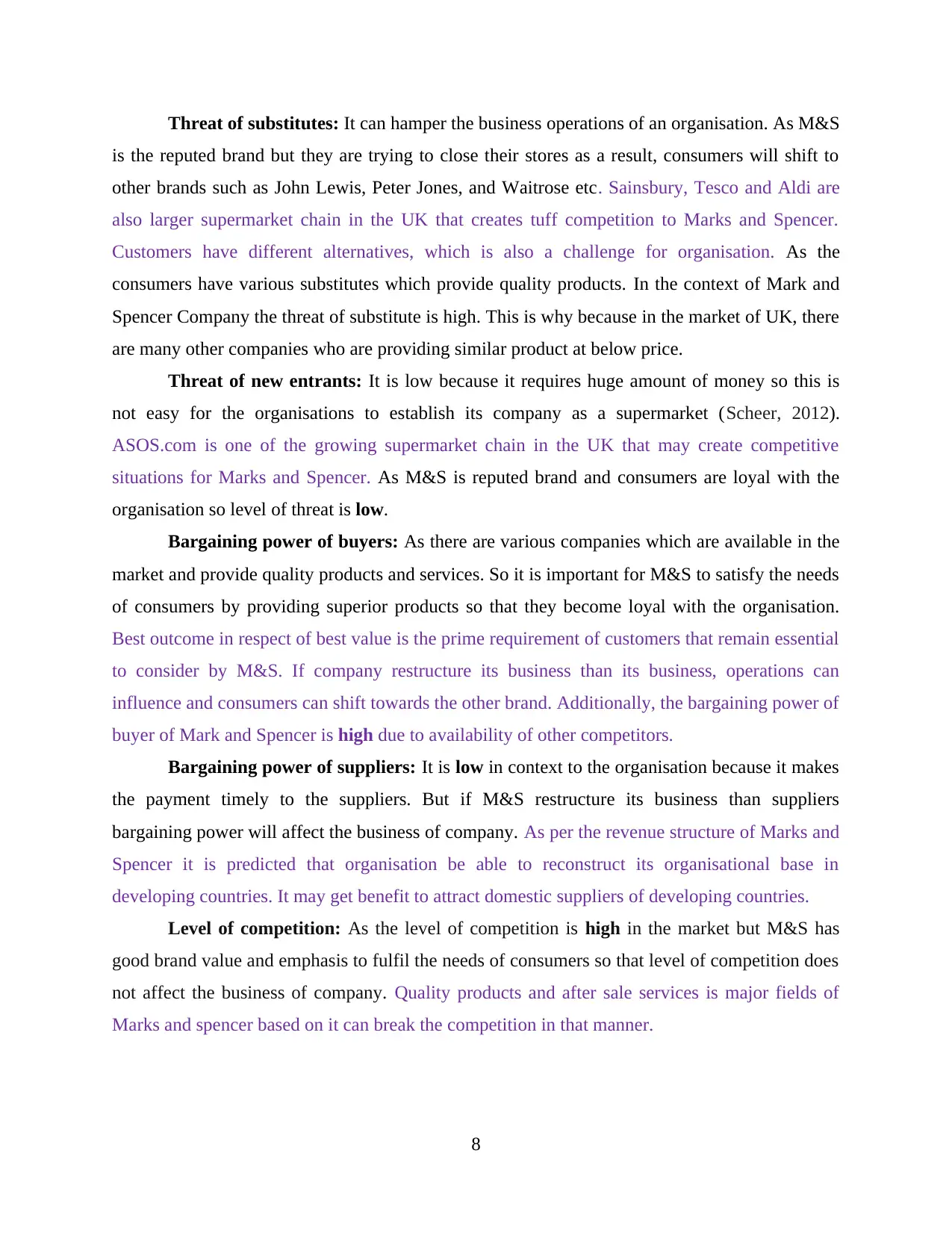
Threat of substitutes: It can hamper the business operations of an organisation. As M&S
is the reputed brand but they are trying to close their stores as a result, consumers will shift to
other brands such as John Lewis, Peter Jones, and Waitrose etc. Sainsbury, Tesco and Aldi are
also larger supermarket chain in the UK that creates tuff competition to Marks and Spencer.
Customers have different alternatives, which is also a challenge for organisation. As the
consumers have various substitutes which provide quality products. In the context of Mark and
Spencer Company the threat of substitute is high. This is why because in the market of UK, there
are many other companies who are providing similar product at below price.
Threat of new entrants: It is low because it requires huge amount of money so this is
not easy for the organisations to establish its company as a supermarket (Scheer, 2012).
ASOS.com is one of the growing supermarket chain in the UK that may create competitive
situations for Marks and Spencer. As M&S is reputed brand and consumers are loyal with the
organisation so level of threat is low.
Bargaining power of buyers: As there are various companies which are available in the
market and provide quality products and services. So it is important for M&S to satisfy the needs
of consumers by providing superior products so that they become loyal with the organisation.
Best outcome in respect of best value is the prime requirement of customers that remain essential
to consider by M&S. If company restructure its business than its business, operations can
influence and consumers can shift towards the other brand. Additionally, the bargaining power of
buyer of Mark and Spencer is high due to availability of other competitors.
Bargaining power of suppliers: It is low in context to the organisation because it makes
the payment timely to the suppliers. But if M&S restructure its business than suppliers
bargaining power will affect the business of company. As per the revenue structure of Marks and
Spencer it is predicted that organisation be able to reconstruct its organisational base in
developing countries. It may get benefit to attract domestic suppliers of developing countries.
Level of competition: As the level of competition is high in the market but M&S has
good brand value and emphasis to fulfil the needs of consumers so that level of competition does
not affect the business of company. Quality products and after sale services is major fields of
Marks and spencer based on it can break the competition in that manner.
8
is the reputed brand but they are trying to close their stores as a result, consumers will shift to
other brands such as John Lewis, Peter Jones, and Waitrose etc. Sainsbury, Tesco and Aldi are
also larger supermarket chain in the UK that creates tuff competition to Marks and Spencer.
Customers have different alternatives, which is also a challenge for organisation. As the
consumers have various substitutes which provide quality products. In the context of Mark and
Spencer Company the threat of substitute is high. This is why because in the market of UK, there
are many other companies who are providing similar product at below price.
Threat of new entrants: It is low because it requires huge amount of money so this is
not easy for the organisations to establish its company as a supermarket (Scheer, 2012).
ASOS.com is one of the growing supermarket chain in the UK that may create competitive
situations for Marks and Spencer. As M&S is reputed brand and consumers are loyal with the
organisation so level of threat is low.
Bargaining power of buyers: As there are various companies which are available in the
market and provide quality products and services. So it is important for M&S to satisfy the needs
of consumers by providing superior products so that they become loyal with the organisation.
Best outcome in respect of best value is the prime requirement of customers that remain essential
to consider by M&S. If company restructure its business than its business, operations can
influence and consumers can shift towards the other brand. Additionally, the bargaining power of
buyer of Mark and Spencer is high due to availability of other competitors.
Bargaining power of suppliers: It is low in context to the organisation because it makes
the payment timely to the suppliers. But if M&S restructure its business than suppliers
bargaining power will affect the business of company. As per the revenue structure of Marks and
Spencer it is predicted that organisation be able to reconstruct its organisational base in
developing countries. It may get benefit to attract domestic suppliers of developing countries.
Level of competition: As the level of competition is high in the market but M&S has
good brand value and emphasis to fulfil the needs of consumers so that level of competition does
not affect the business of company. Quality products and after sale services is major fields of
Marks and spencer based on it can break the competition in that manner.
8
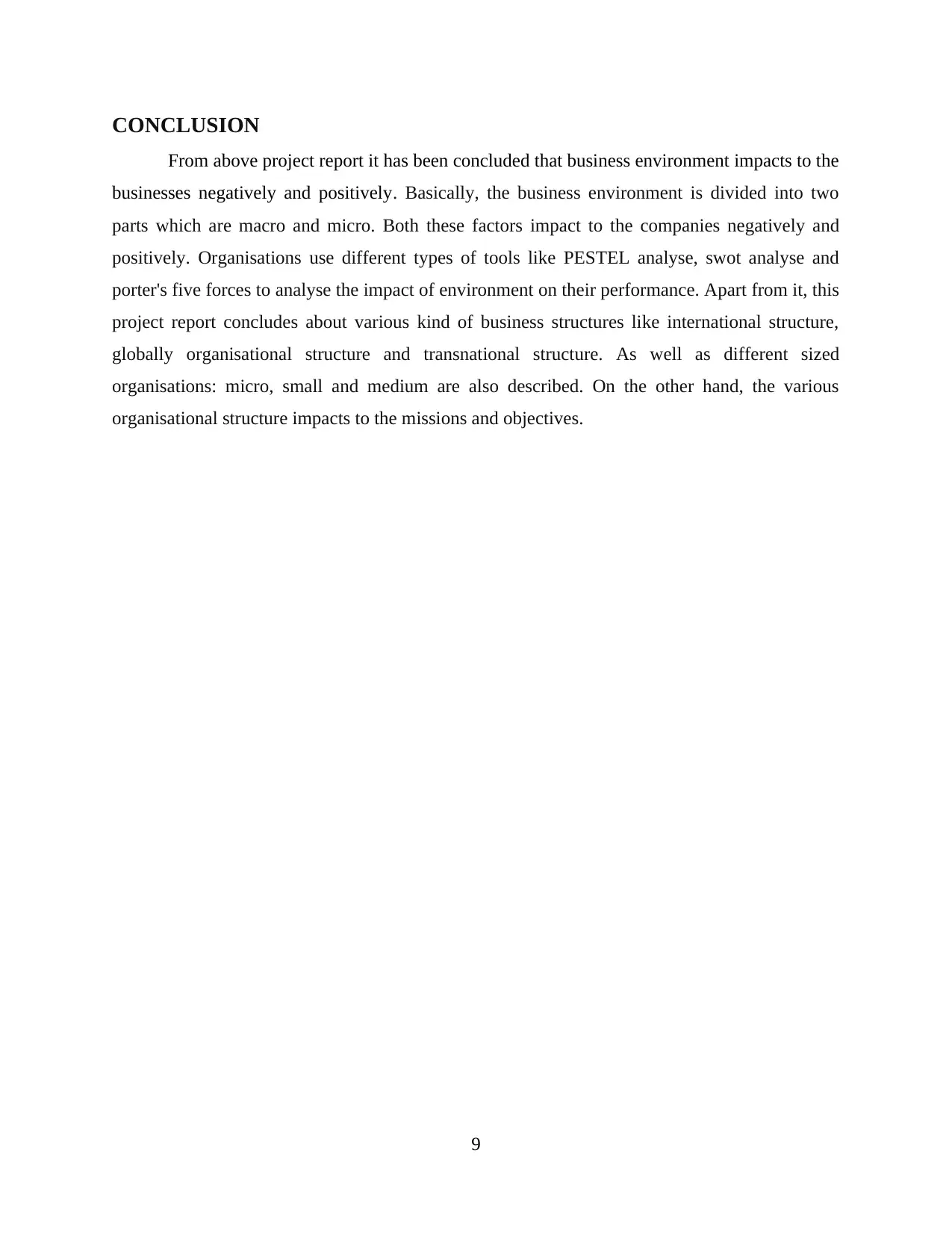
CONCLUSION
From above project report it has been concluded that business environment impacts to the
businesses negatively and positively. Basically, the business environment is divided into two
parts which are macro and micro. Both these factors impact to the companies negatively and
positively. Organisations use different types of tools like PESTEL analyse, swot analyse and
porter's five forces to analyse the impact of environment on their performance. Apart from it, this
project report concludes about various kind of business structures like international structure,
globally organisational structure and transnational structure. As well as different sized
organisations: micro, small and medium are also described. On the other hand, the various
organisational structure impacts to the missions and objectives.
9
From above project report it has been concluded that business environment impacts to the
businesses negatively and positively. Basically, the business environment is divided into two
parts which are macro and micro. Both these factors impact to the companies negatively and
positively. Organisations use different types of tools like PESTEL analyse, swot analyse and
porter's five forces to analyse the impact of environment on their performance. Apart from it, this
project report concludes about various kind of business structures like international structure,
globally organisational structure and transnational structure. As well as different sized
organisations: micro, small and medium are also described. On the other hand, the various
organisational structure impacts to the missions and objectives.
9

10
Paraphrase This Document
Need a fresh take? Get an instant paraphrase of this document with our AI Paraphraser
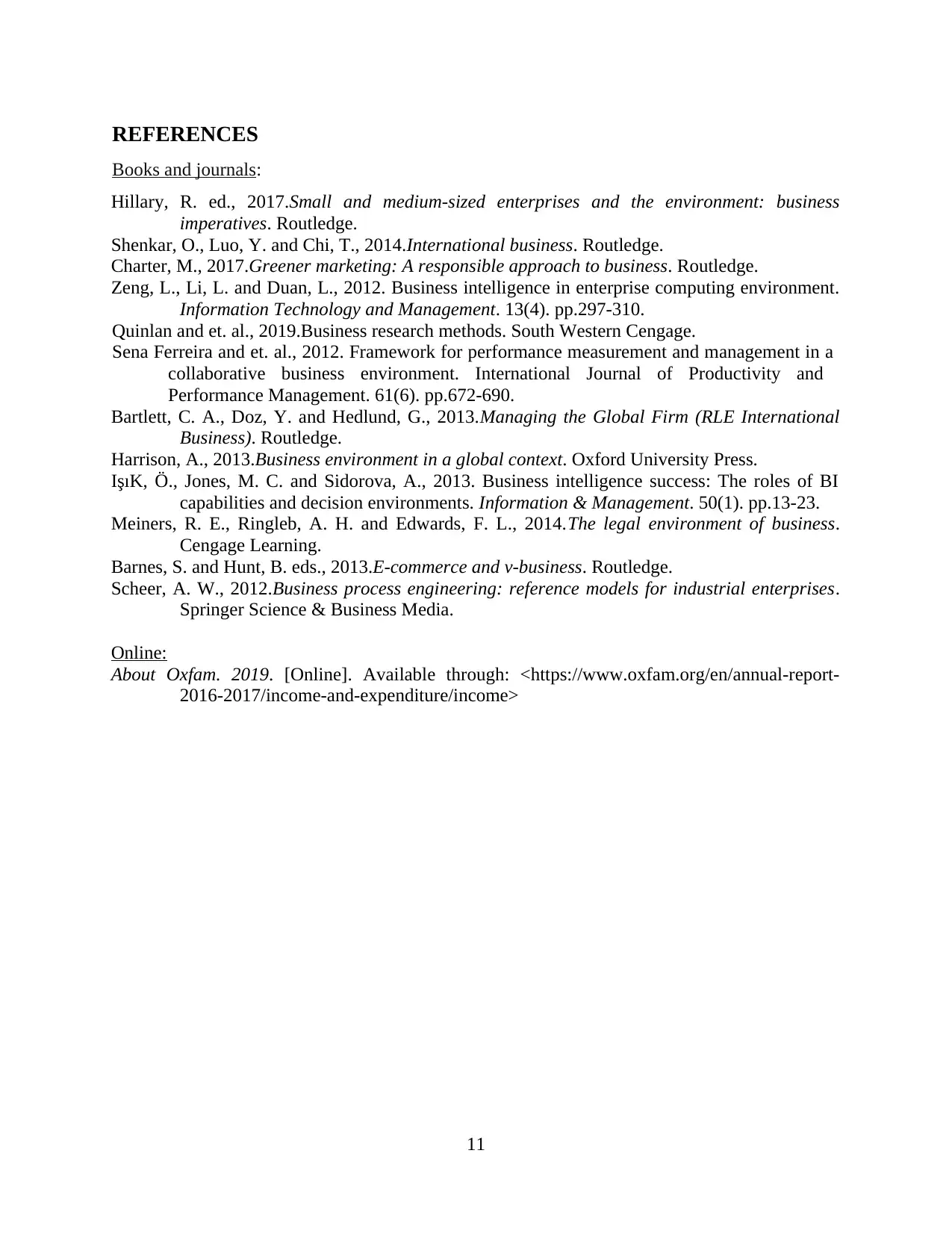
REFERENCES
Books and journals:
Hillary, R. ed., 2017.Small and medium-sized enterprises and the environment: business
imperatives. Routledge.
Shenkar, O., Luo, Y. and Chi, T., 2014.International business. Routledge.
Charter, M., 2017.Greener marketing: A responsible approach to business. Routledge.
Zeng, L., Li, L. and Duan, L., 2012. Business intelligence in enterprise computing environment.
Information Technology and Management. 13(4). pp.297-310.
Quinlan and et. al., 2019.Business research methods. South Western Cengage.
Sena Ferreira and et. al., 2012. Framework for performance measurement and management in a
collaborative business environment. International Journal of Productivity and
Performance Management. 61(6). pp.672-690.
Bartlett, C. A., Doz, Y. and Hedlund, G., 2013.Managing the Global Firm (RLE International
Business). Routledge.
Harrison, A., 2013.Business environment in a global context. Oxford University Press.
IşıK, Ö., Jones, M. C. and Sidorova, A., 2013. Business intelligence success: The roles of BI
capabilities and decision environments. Information & Management. 50(1). pp.13-23.
Meiners, R. E., Ringleb, A. H. and Edwards, F. L., 2014.The legal environment of business.
Cengage Learning.
Barnes, S. and Hunt, B. eds., 2013.E-commerce and v-business. Routledge.
Scheer, A. W., 2012.Business process engineering: reference models for industrial enterprises.
Springer Science & Business Media.
Online:
About Oxfam. 2019. [Online]. Available through: <https://www.oxfam.org/en/annual-report-
2016-2017/income-and-expenditure/income>
11
Books and journals:
Hillary, R. ed., 2017.Small and medium-sized enterprises and the environment: business
imperatives. Routledge.
Shenkar, O., Luo, Y. and Chi, T., 2014.International business. Routledge.
Charter, M., 2017.Greener marketing: A responsible approach to business. Routledge.
Zeng, L., Li, L. and Duan, L., 2012. Business intelligence in enterprise computing environment.
Information Technology and Management. 13(4). pp.297-310.
Quinlan and et. al., 2019.Business research methods. South Western Cengage.
Sena Ferreira and et. al., 2012. Framework for performance measurement and management in a
collaborative business environment. International Journal of Productivity and
Performance Management. 61(6). pp.672-690.
Bartlett, C. A., Doz, Y. and Hedlund, G., 2013.Managing the Global Firm (RLE International
Business). Routledge.
Harrison, A., 2013.Business environment in a global context. Oxford University Press.
IşıK, Ö., Jones, M. C. and Sidorova, A., 2013. Business intelligence success: The roles of BI
capabilities and decision environments. Information & Management. 50(1). pp.13-23.
Meiners, R. E., Ringleb, A. H. and Edwards, F. L., 2014.The legal environment of business.
Cengage Learning.
Barnes, S. and Hunt, B. eds., 2013.E-commerce and v-business. Routledge.
Scheer, A. W., 2012.Business process engineering: reference models for industrial enterprises.
Springer Science & Business Media.
Online:
About Oxfam. 2019. [Online]. Available through: <https://www.oxfam.org/en/annual-report-
2016-2017/income-and-expenditure/income>
11
1 out of 14
Related Documents
Your All-in-One AI-Powered Toolkit for Academic Success.
+13062052269
info@desklib.com
Available 24*7 on WhatsApp / Email
![[object Object]](/_next/static/media/star-bottom.7253800d.svg)
Unlock your academic potential
© 2024 | Zucol Services PVT LTD | All rights reserved.




